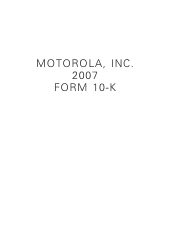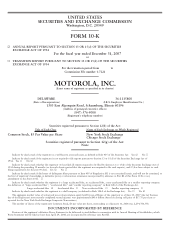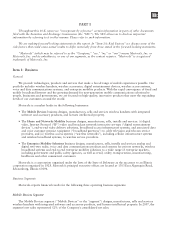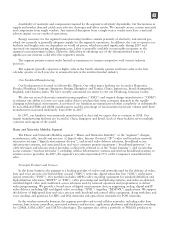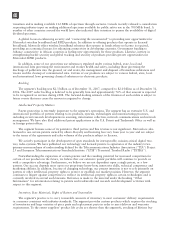Motorola 2007 Annual Report Download - page 15
Download and view the complete annual report
Please find page 15 of the 2007 Motorola annual report below. You can navigate through the pages in the report by either clicking on the pages listed below, or by using the keyword search tool below to find specific information within the annual report.
efforts that impact the deployment of new equipment, (v) new legislation and regulations affecting the equipment
sold by the segment, and (vi) general economic conditions.
In 2007, the home business benefited from increased spending by operators on our products due to the
increase in video and data subscribers and the deployment of advanced video platforms by cable operators for
HD/DVR applications, as well as from spending by telecom operators upgrading their networks and adding
video services. We expect this industry to continue to grow in 2008, driven by continued expansion of broadband
network capacity and services.
In 2007, the overall market for traditional CDMA wireless networks was relatively flat and the overall
markets for GSM and iDEN wireless networks were down. Forecasted industry trends point to a decline in the
CDMA, GSM and iDEN markets in 2008 as next-generation 3G and WiMAX wireless networks are deployed.
Sales in the overall wireless network market are expected to be flat, or up slightly, in 2008.
Our Strategy
The Home and Networks Mobility segment is focused on leadership in next-generation broadband solutions
to accelerate the delivery of personal media experiences. Key elements in the segment’s strategy include:
(i) providing for seamless convergence of services and applications across delivery platforms within the home and
across wireline and wireless networks, (ii) innovating and optimizing our end-to-end network portfolio, and
(iii) developing new services that leverage our platforms to provide revenue-generating applications and services to
our operator customers while enabling consumers to experience media mobility.
In the home business, we are focused on accelerating the rate of digital penetration by broadband operators in
North America through an enhanced suite of digital entertainment devices. These products include basic models
supporting the industry movement to all-digital delivery and advanced units supporting HD/DVR functions. We
are capitalizing on telecom operators decisions to offer IPTV to their subscribers globally, with products that
support delivery of video content using both copper-outside-plant and fiber-to-the-premises (“FTTP”) networks.
During the year, the segment continued to provide video infrastructure, FTTP access network equipment and
advanced digital entertainment devices for the launch of Verizon’s FiOS service and is supplying IP interactive set-
tops to leading telecommunication companies around the world, including AT&T, SingTel and Telia Sonera.
We are also enhancing and expanding our voice and data portfolio to offer end-to-end solutions for fixed-mobile
convergence and next-generation converged IP-based voice, data and video delivery. These solutions include:
(i) broadband gateways with support for handing off a mobile voice or data call to a carrier’s VoIP or data network,
and (ii) next-generation infrastructure products enhancing our cable modem termination system (“CMTS”) and PON
platforms to expand the bandwidth delivered to a home or business. We developed our first Femtocell gateway in
2007, which enables consumers to connect to a wireless service provider’s network via a DSL or cable broadband
connection. We are also an industry leader in broadband infrastructure solutions, introducing DOCSIS 3.0 channel
bonding on our CMTS and cable modems and commercially deploying our Gigabit PON platform.
In order to enhance our strategy, as well as increase our offerings to wireline carriers, we have completed several
strategic acquisitions. During 2007, we completed the acquisition of Netopia, Inc., a broadband equipment provider
for DSL customers, which allows for phone, TV and fast Internet connections. We also acquired: (i) Tut Systems,
Inc., a leading developer of edge routing and video encoders; (ii) Terayon Communication Systems, Inc., a provider
of real-time digital video networking applications to cable, satellite and telecommunication service providers
worldwide; (iii) Modulus Video, Inc., a provider of MPEG-4 Advanced Coding compression systems designed for
delivery of high-value video content in the IP set-top devices for the digital video, broadcast and satellite
marketplaces; and (iv) Leapstone Systems, Inc., a provider of intelligent multimedia service delivery and content
management solutions to networks operators. These acquisitions enhance our ability to: (i) provide complete
solutions to operators as they deploy advanced services, (ii) assist operators in growing their on-demand content
offerings, deploying switched digital video technology, and enabling targeted advertising solutions, and (iii) provide
end-to-end video solutions to wireline and wireless operators as they add video to their service offerings.
In the wireless networks business, the segment is investing to be a leader in next-generation wireless
broadband technologies with its WiMAX solution. Because of its projected quicker time to market, expected lower
cost and expected superior performance, the WiMAX wireless broadband technology, which is based on the IEEE
standard 802.16e, represents a compelling offering for existing operators and emerging broadband service
providers. In 2007, the segment delivered WiMAX network equipment to Wateen Telecom in Pakistan and Sprint
Nextel and Clearwire in the United States. In addition, at the end of 2007, the segment was participating in over
7


